
Every city has its gates, which need not be of stone. Nor need soldiers be upon them or watchers before them. At first, when cities were jewels in a dark and mysterious world, they tended to be round and they had protective walls. To enter, one had to pass through gates, the reward for which was shelter from the overwhelming forests and seas, the merciless and taxing expanse of greens, whites, and blues—wild and free—that stopped at the city walls.
In time the ramparts became higher and the gates more massive, until they simply disappeared and were replaced by barriers, subtler than stone, that girded every city like a crown and held in its spirit. Some claim that the barriers do not exist, and disparage them. Although they themselves can penetrate the new walls with no effort, their spirits (which, also, they claim do not exist) cannot, and are left like orphans around the periphery.
To enter a city intact it is necessary to pass through one of the new gates. They are far more difficult to find than their solid predecessors, for they are tests, mechanisms, devices, and implementations of justice. There once was a map, now long gone, one of the ancient charts upon which colorful animals sleep or rage. Those who saw it said that in its illuminations were figures and symbols of the gates. The east gate was that of acceptance of responsibility, the south gate that of the desire to explore, the west gate that of devotion to beauty, and the north gate that of selfless love. But they were not believed. It was said that a city with entryways like these could not exist, because it would be too wonderful. Those who decide such things decided that whoever had seen the map had only imagined it, and the entire matter was forgotten, treated as if it were a dream, and ignored. This, of course, freed it to live forever.
— Mark Helprin, Winter's Tale
I was fortunate to have Winter's Tale published shortly after I arrived, and while I was still finding my way around New York City. It was a good and reliable guide and map to the overwhelming engine and labyrinth that is eight million souls swarming together on the Hudson River, especially for a poor and naive immigrant from the Western wastes.
Years later, knowing how much I loved the book, my young daughter presented me the very copy I had bought in 1983 for Christmas, having scrawled "For Daddy Love" along with her and her brother's names in colored pen on its cloth cover boards.
One can have worse souvenirs, guides, and ticket stubs from the chief journey of one's life.
© 2010 The Epicurean Dealmaker. All rights reserved.
